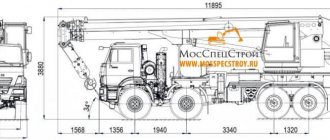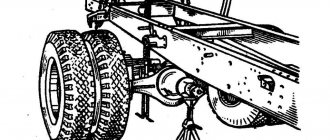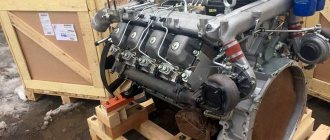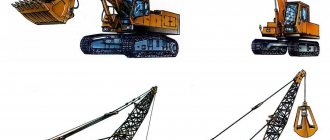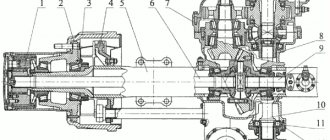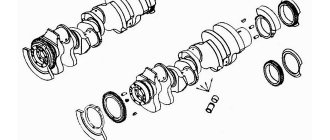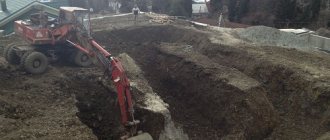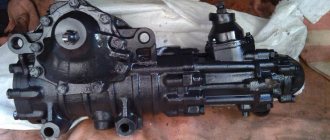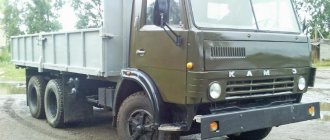Marcopolo Bravis assembled by the Neftekamsk Automobile Plant. Photo Wikipedia
In December 2012, on the territory of the Neftekamsk Automobile Plant, a joint venture of KamAZ PJSC and the world's largest bus manufacturer, Brazilian Marcopolo SA - KamAZ-Marco JV - began assembling small-class Bravis buses on a chassis designed at KamAZ PJSC. The model complies with Euro-4 standards and has components from the world's largest companies : Cummins engine, ZF gearbox, Daimler axle and axle, Knorr-Bremse brake system.
History of creation
The bus named Bravis is the product of joint efforts of KAMAZ and the famous Marcopolo group of companies (Brazil). Since 2008, the Brazilian manufacturer has been trying to gain a foothold in the Russian market. His first joint experience was a joint venture with. As part of it, large tourist buses Andare 850 and 1000 , and Real, very similar to Bravis, only on the Hyundai County chassis, was assembled at another production site in Pavlov-on-Oka.
City bus Bravis-11. Photo NefAZ
A new agreement on the creation of a joint venture with KamAZ, called KamAZ-Marko, was signed in September 2011. It envisaged serial production of Bravis buses (in urban and suburban versions) on the Chelny chassis with index 3297 from December 2012. The basic models were called Bravis-3297 or NefAZ-3297. City and suburban versions differ in the number of seats, interior configuration and overall height (suburban is slightly higher). According to the plans of the manufacturers, in 2013 the production volume should have been at least 300 units, which, alas, was not achieved due to the lack of interest in the bus among carriers at that time.
The production of such vehicles had already been established at a subsidiary in Neftekamsk, the model was called NefAZ-3299. The bus was based on a KAMAZ-4307 chassis with a Brazilian-assembled 4-cylinder Cummins turbocharged diesel engine producing 140 hp. p., mechanical 5-speed ZF gearbox with cable shift drive and RBL steering (Germany). Disc brakes were installed on all wheels.
NefAZ received a body with a welded frame made of rectangular steel pipes, lined with galvanized sheets, parts of the front and rear masks made of fiberglass, and doors with electro-pneumatic control. For passengers, one double-leaf door was offered for the urban version and two single-leaf doors for the intercity version, which was due to the short length of the bus. The car did not go into large production: then low demand, apparently, greatly clouded the prospects.
It was not for nothing that KamAZ agreed to unite the efforts of Russian and foreign manufacturers. The trump card of this relationship is to reduce the cost of equipment, the time required to prepare technical documentation and personnel...
JOINT DEVELOPMENT OF KAMAZ OJSC AND MARCOPOLO SA - presentation
JOINT DEVELOPMENT OF KAMAZ OJSC AND MARCOPOLO SA
KAMAZ-Marco LLC In 2012, the world-famous group of companies Marcopolo SA (Brazil) and the largest domestic automobile corporation KAMAZ OJSC created the joint venture KAMAZ-Marco LLC. The main goal of the joint venture is to organize the production and sales in the Russian Federation and CIS countries of Marcopolo buses based on KAMAZ bus chassis that meet environmental standards Euro-4 and higher and meet modern requirements for equipment for transporting passengers. The buses are produced at the facilities of a subsidiary of KAMAZ OJSC - NEFAZ OJSC - in Neftekamsk, Republic of Bashkortostan. The projected capacity by 2016 will be about 3 thousand units per year. KAMAZ-Marko buses are a combination of innovative solutions, advanced technologies that anticipate the needs of carriers and the latest trends in bus construction. About co-production
Exterior of the KAMAZ-Marko LLC bus
Interior of a KAMAZ-Marko LLC bus
BRAVIS*: category M3 (gross weight 9.5 t, length 7.7 m), class I (urban), 50 passengers (20 seats) * BRAVIS (BRAVIS) is registered by the joint venture as a trademark General characteristics of KAMAZ-Marko LLC
Vehicle category M3, class I Modifications BRAVIS-10 without driver's door, BRAVIS-11 with driver's door Passenger capacity 50 seats, incl. 20 seated Overall dimensions, mm Length 7757 Width 2370 Height 2920 Wheelbase, mm Curb weight, kg Gross weight, kg KAMAZ-Marko LLC
The bus uses units from the world's leading manufacturers. Engine Cummins ISB4.5e4 185B EURO-4, 4-cylinder, volume 4.5 l, power 185 hp. Exhaust gas aftertreatment system SCR Gearbox ZF 6S710 BO, mechanical, 6-speed Clutch SACHS MF 362, dry, single-disc power steering integral type PPT Front axle Mercedes VL2 Rear axle Mercedes HL2, hypoid Braking system dual-circuit, pneumatic, with ABS WABCO and ASR, Knorr-Bremse disc brakes 17.5-inch wheels Front spring suspension, with shock absorbers and anti-roll bars Rear suspension, pneumatic, with shock absorbers and anti-roll bars KAMAZ-Marko LLC
Reliability and quality Rear axle and front axle. Safety The brakes on all wheels are disc. Brake system – Knorr-Brenze. Comfort The rear suspension is pneumatic. Aesthetics. The design is modern. LED lighting technology; Matador tires Durability and modernity. Body. : glued sidewalls, no welding - quick replacement in case of accidents; Glued-in side windows with cut-out windows Adjustment of headlights from the driver's seat Interior trim made of composite (Alum + ABS) plastic, which in an accident does not break into sharp parts (like formica - used by our competitors) safety; Thermal and sound insulation of the body is based on polyurethane, not foam plastic (like competitors) - comfort and additional safety, thanks to the strength characteristics of PU. OTTS, KAMAZ-Marko LLC Design advantages of the bus
KAMAZ-Marko LLC © KAMAZ-Marko Copyright reserved. No part of this presentation may be reproduced or transmitted in any form or by any means without the prior written permission of KAMAZ-Marko LLC. Contact information for more detailed information on purchasing BRAVIS buses: Exclusive distributor KAMAZ-Marko LLC, Naberezhnye Chelny, Khasan Tufan Avenue, 12, Business, office 1710 Telephone/fax: (8552) General Director: Ilshat Singatullin Tel .: Sales Director: Dmitry Isaev Tel.: Official dealer of VostokAvtoTrans LLC, Russian Federation, Moscow, st. Viktorenko, 5, building 1, office 9A Phone/fax: + 7 (495) , (495) Sales Director - VostokAvtoTrans LLC: Radik Faizov Tel.: +7 (495) ,
Detailed description and design of basic models
...Therefore, the Bravis body is an exclusively Brazilian brainchild , which is based on a box-shaped frame welded from galvanized pipes. The lower transverse power elements are made of a powerful profile measuring 80x50 mm, connected by longitudinal beams of slightly smaller dimensions 50x25 mm.
The body frame - front, rear and roof - is welded together in stocks. After assembly on a slipway, wheel arches and part of the galvanized steel cladding are welded into the body. The fully welded frame is sent to the priming chamber, after which it is sheathed. Pre-welded seams are coated with bitumen mastic so that corrosion does not corrode the metal exposed from under the burnt zinc.
Diagram of the interior of the Bravis-20 commuter bus. Photo NefAZ
In addition, a vibration isolator is glued , which will eliminate the unpleasant noise of panels vibrating when moving. The sides of Bravis are made of galvanized steel and aluminum sheets . The lower part, the skirt with a height of just over 300 mm, is additionally treated for greater anti-corrosion resistance. In addition, the porous insulator underneath prevents contact between steel and aluminum, which means the formation of a galvanic couple and corrosion.
The interior of the bus, sheathed on the outside, is lined with thermal and noise insulation - 40 mm thick polyurethane, which allows it to be operated at temperatures from -50 to +500 C. The interior is lined with composite (Alum + ABS) plastic, which does not burst into sharp fragments in the event of an accident . , the method of fastening the windshield will be a significant advantage . It is laid in a rubber profile, and not glued, as has become fashionable now. Here, replacing broken glass is as easy as shelling pears, and will take no more than an hour. Replacing the side glazing will take much more time: windows with cut out vents are glued into the opening.
NefAZ-3297 has the following external dimensions: 7757 mm in length, of which 3950 mm is the space between the wheel pairs, 2370 mm in width (excluding side mirrors) and 2920-3042 mm in height. When equipped, the bus weighs from 6000 to 6755 kg, depending on the modification, and its total weight varies from 9500 to 9930 kg. The car has a pressure of 3600-3930 kg on the front axle, and 5900-6000 kg on the rear axle.
The interior of the city version has 21 anti-vandal plastic seats with fabric inserts. The interior layout provides a rear storage area that allows you to place a small stroller. The commuter version has 27 more comfortable seats.
The driver's workplace is separated from the passenger compartment only by a symbolic partition on the side of the seat back. However, having sat behind the wheel, a professional will feel quite comfortable: the sprung seat is equipped with a stiffness adjustment mechanism, the steering wheel (with the KamAZ brand logo) has a thickness that is convenient for its coverage and an optimal diameter, and the gearbox shift mechanism, thanks to a cable drive, has good selectivity at low speeds. There are also no complaints about visibility from the driver’s seat: a large windshield area is combined with well-placed side mirrors equipped with heating.
Scheme of the city bus Bravis-11-M5. Photo NefAZ
The driver has a modern instrument panel with analogue and digital gauges (including a text message display). On the right hand are the control keys for heating, lighting, door drives and lighting devices. There is also a key for adjusting the direction of the headlights. Quite unusually, on the left side of the dashboard, the parking brake lever is located. Whether this is convenient or not is a matter of practice, but when boarding the driver from the passenger compartment, this would serve as an additional obstacle.
You can check the oil and coolant levels while sitting behind the wheel: the engine compartment is accessible from the passenger compartment, the cover is located to the right of the driver . But the air filter, batteries and autonomous heater are serviced from the street; these units are located in the side compartments. The issue of placing the spare tire has been solved in an interesting way: it is fixed under the floor in the rear overhang, and access to the lifting mechanism opens from the steps in the rear doorway.
For NefAZ-3297, two power units are provided , each of which is installed together with a 6-speed “manual” transmission (ZF 6S700 TO or ZF 6S710 BO), a dry single-plate clutch and a driven rear axle (with a locked cross-axle differential): Basic version - diesel “four” Cummins ISB4.5e4-185B with a displacement of 4.5 liters with a vertical layout, turbocharging, Common Rail “power” technology and an intercooler, which produces 178 horsepower at 2300 rpm and 686 Nm of torque at 1400 rpm. An alternative to it is the Yuchai YC4G190N-50 four-cylinder gas unit with a volume of 5.3 liters with a vertical arrangement of “pots”, a turbocharger, water cooling and direct fuel injection, producing 183 hp. at 2300 rpm and 660 Nm of available potential at 1400 rpm. The maximum speed of the vehicle does not exceed 90 km/h (regardless of modification).
The diesel bus is equipped with a 125-liter fuel tank, and in combined driving conditions it consumes no more than 18 liters of fuel for every “hundred”, while the gas version is equipped with four metal-composite cylinders with a capacity of 393 liters, providing a range of 350-400 km without refueling.
The bus is equipped with dependent suspensions on both axles with hydraulic shock absorbers and anti-roll bars “in a circle”: at the front - on two leaf springs, and at the rear - on two pneumatic elements. The machine is equipped with a steering mechanism with integrated hydraulic power steering and a dual-circuit braking system with pneumatic drive, disc brakes (with automatic clearance adjustment) on all wheels, ABS and ASR.
General view of Bravis buses. Photo NefAZ
The bus is very dynamic , which will allow it to fit well into the traffic flow. Gears shift smoothly, without jerking. Of course, in an urban environment, an automatic transmission could be a worthy alternative to a manual transmission, but the manufacturer does not yet provide for its installation. It is worth especially noting the operation of disc brakes: there is almost no characteristic lag when pressing the brake pedal, and deceleration is clearly regulated by changing the force of pressing the brake pedal.
Passengers should appreciate the smooth ride of a bus with air suspension and the calmer response of the body to driving over uneven surfaces: vibration was only occasionally noticeable, but without any plastic rattling.
As for operating costs , the average fuel consumption of Bravis (according to the manufacturer) in winter does not exceed 22 liters, the service interval is 15 thousand km, and the frequency of engine oil changes is 30 thousand km. KAMAZ-Marko buses are serviced by the dealer network of KamAZ OJSC. All this gives us reason to believe that the bus will be able to occupy a place in its niche in the market. We hope drivers and passengers will also appreciate the new product.
In the initial configuration , the bus can boast of: a sprung driver's seat, an on-board network protection device, electro-pneumatic passenger doors, tinted windows, a radio with four speakers, ABS, ASR, power steering, heated side mirrors and some other equipment.
As of 2022, the manufacturer offers 4 models of Bravis buses: 2 modifications for the city and 2 for the suburbs. It is their characteristics that are presented below in the following order: diesel city BRAVIS-11, diesel suburban BRAVIS-20, gas city BRAVIS-11-M5 and gas suburban BRAVIS-20-M5. Some parameters are similar for all or only two modifications. The company is constantly working on modernizing buses, so it is recommended that you familiarize yourself with the current characteristics on the manufacturer’s website.
autotune
NefAZ-3297 is a small-class bus with a 4×2 wheel arrangement, which (depending on the modification) is designed to transport passengers on city or suburban routes and is adapted for stable operation even in difficult weather conditions (with outside temperatures from -50 up to +50 degrees Celsius)… The world presentation of the machine took place in September 2011 at the specialized exhibition “ComTrans-2011”, and its serial production was launched in Neftekamsk already in 2012. NefAZ-3297 has the following external dimensions: 7757 mm in length, of which 3950 mm is the space between the wheel pairs, 2370 mm in width (excluding side mirrors) and 2920-3042 mm in height.
When equipped, the bus weighs from 6000 to 6755 kg, depending on the modification, and its total weight varies from 9500 to 9930 kg. The car has a pressure of 3600-3930 kg on the front axle, and 5900-6000 kg on the rear axle. The interior of the city version of NefAZ-3297 has 21 vandal-proof plastic seats with fabric inserts, and the suburban version has 26 seats (the total number of seats, including standing passengers, is 45-50 and 42, respectively). Inside the bus there is a rear storage area that allows you to place a small stroller, and the driver’s workplace (equipped with a sprung seat) is separated from the passenger compartment by a symbolic partition. For NefAZ 3297, two power units are provided, each of which is installed side by side with a 6-speed “manual” transmission (ZF 6S700 TO or ZF 6S710 BO), a dry single-plate clutch and a driven rear axle (with a locking cross-axle differential):
The basic option is a Cummins ISB4.5e4-185B diesel four with a displacement of 4.5 liters with a vertical layout, turbocharging, Common Rail power technology and an intercooler, which produces 178 horsepower at 2300 rpm and 686 Nm of torque at 1400 rpm /minute. An alternative to it is the Yuchai YC4G190N-50 four-cylinder gas unit with a volume of 5.3 liters with a vertical arrangement of “pots”, a turbocharger, water cooling and direct fuel injection, producing 183 hp. at 2300 rpm and 660 Nm of available potential at 1400 rpm. The maximum speed of the vehicle does not exceed 90 km/h (regardless of modification). The diesel bus is equipped with a 125-liter fuel tank, and in combined driving conditions it consumes no more than 18 liters of fuel for every “hundred”, while the gas version is equipped with four metal-composite cylinders with a capacity of 393 liters, providing a range of 350-400 km without refueling.
At the heart of BRAVIS-3297 is a ladder-type frame, consisting of a pair of spars of constant cross-section in a channel configuration, which are connected to each other by cross members. It has a carriage-type body, which is a welded frame made of galvanized pipes (its front and rear masks are made of fiberglass, and the side panels and roof are made of aluminum sheets). The bus is equipped with dependent suspensions on both axles with hydraulic shock absorbers and anti-roll bars “in a circle”: at the front - on two leaf springs, and at the rear - on two pneumatic elements.
The machine is equipped with a steering mechanism with integrated hydraulic power steering and a dual-circuit braking system with pneumatic drive, disc brakes (with automatic clearance adjustment) on all wheels, ABS and ASR. On the Russian market “Marcopolo Bravis” NefAZ-3297 in 2022 is offered at a price of ~3 million rubles. In the initial configuration, the bus can boast of: a sprung driver's seat, an on-board network protection device, electro-pneumatic passenger doors, tinted windows, a radio with four speakers, ABS, ASR, power steering, heated side mirrors and some other equipment.
Specifications
- Fuel type. Diesel; gas.
- Fuel tank capacity, l. 125; 320 (80x4 cylinders).
- Curb and technically permissible weight, kg. 6000 and 9500; 6755 and 9930.
- Load on front/rear axle based on technically permissible weight, kg. 3600/5900; 3930/6000.
- Steering gear. With hydraulic booster.
- Brake system. Working. The brakes on all wheels are disc. Auxiliary. Engine brake retarder.
Engine/powertrain characteristics
- Model. Cummins ISF3.8S 5168; WEICHAI, WP4.1NG150E51.
- Type. Diesel; gas.
- Number and arrangement of cylinders. 4, in-line.
- Environmental safety standards. Euro-5.
- Working volume, l. 3,76; 4,088.
- Engine power, kW (hp)/min. 122 (165,9); 102,5 (139,4).
- Maximum torque, Nm/min. 592; 500.
- Checkpoint. Fast Gear 6DS60T manual transmission.
- Front-rear axle suspension. Dependent, spring-Dependent, pneumatic.
- Maximum speed, km/h. 80.
